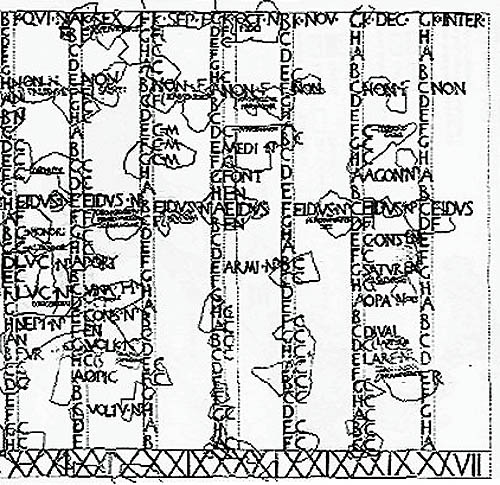The Longest Year in History
Today, UH scholar Richard Armstrong tells us about the longest year in history. The Honors College at the University of Houston presents this series about the machines that make our civilization run, and the people whose ingenuity created them.
What was the longest year in history? It sounds like a silly question, but it's not. There is a correct answer: It was 46 BC. Julius Caesar stretched that year out to a whopping size. He wanted to make the following year begin at the right time again: that is, after the winter solstice.
Using the best astronomy and mathematics of the time, Caesar tinkered the old Roman calendar to make it fit the reality of the solar year. That's the year of 365 days (plus a few hours) that we take for granted today. We still divide it into 12 months, and still call them by their Roman names. But to begin this new measure of time, Caesar declared a transitional year of 445 days. It was known as the "last year of confusion." People began the year 46 making plans in the usual way, but suddenly they were told: the year would have three additional months. Imagine how that could affect your mortgage!
Before Caesar's reform, the Roman calendar was in a terrible mess. Originally, it was based on the moon, not the sun. Lunar calendars take their dates from observed lunar phases -- new moon to full moon and back again. The priests of Rome juggled a shifting 12-month calendar that ran at least ten days behind the solar year. In theory, they could tack additional days onto February every other year to make calendar dates coincide more with the natural seasons. But this meant that the priests had to pay attention and make adjusting the calendar a serious priority. However, the years before Caesar's rise to power were extremely turbulent. The calendar slipped farther and farther behind amid all the political turmoil. Harvest festivals no longer fell at harvest time.
If the old calendar system seems arbitrary, remember what a calendar was in those days. We think of the calendar as a universal measure of time. It's like a perfect grid that can be extended endlessly into the future. There's a website that tells me my birthday in the year 2128 will fall on a Monday.
But in antiquity, calendars were simply ways of organizing religious festivals, the terms of contracts, and other social arrangements. People knew calendars could be shifted and manipulated-even for political reasons. Priests and officials "kept" the time, and different calendars were in use throughout the world. Calendar time simply wasn't as fixed back then. An ancient calendar was more like a schedule, subject to change and revision.
So Caesar's reform was all the more remarkable. As both high priest and dictator of Rome, he had the authority to impose a whole new scheme on the Roman world. Cicero joked that this man now wished to control the very stars, which rose according to his new calendar as if by edict. Caesar's calendar still needed some minor adjustments, but Europe never got another jumbo year like 46 BC. And to this day, we are still marching along on Caesar's time.
I'm Richard Armstrong at the University of Houston, where we're interested in the way inventive minds work.
D. E. Duncan, Calendar: Humanity's Epic Struggle to Determine a True and Accurate Year. (New York: Avon Books, 1998).
This best-selling book is a broad survey and, though scholarly, is an entertaining read about many aspects of time reckoning in the ancient world: D. Feeney, Caesar's Calendar: Ancient Time and the Beginnings of History.(Berkeley, CA: University of California Press, 2007).
Click here for an online article on calendars in general.
Click here for an online article on the Roman calendar.

The example above is a half of a Roman Republican calendar before Julius Caesar's reform (courtesy of Wikipedia Commons). To see the whole calendar, click here or on the image above.
At the top are the month names (Sep, Oct, Nov, Dec), but notice July and August -- later to be named after Julius and Augustus Caesar-still bear the old names Quintilis and Sextilis ("fifth month," "sixth month"). Also at the far right a month is labeled INTER, which stands for the extra intercalary month added every two years or so to make the calendar stay in step with the solar year. At the bottom in Roman numerals are the old day totals for those months, which do not coincide with our totals. The letters running down in columns are simply marking an eight-day market cycle, which does not coincide with the scheme of months. The Romans did not yet have a 7-day planetary week like ours.
Days were reckoned individually this way: first of the month was called the kalends (marked K here), then one counted down toward the nones (marked NON), then counted down again toward the ides (marked EIDVS). From the ides, one reckoned towards the next kalends, that is, the beginning of the next month. The system seems very odd to us, because it means on this calendar November 14 would be called "the sixteenth day before the kalends of December." It is assumed that the system is based on the original practice of lunar observations. At the kalends, the pontiffs would "call" (calare) a new moon; nones would be the half moon, and ides the full moon. From there one simply disregarded the phases of the waning moon and looked forward to the calling of the next new moon.